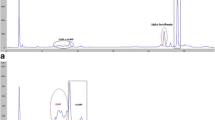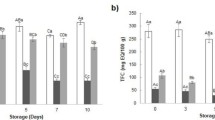Abstract
Vegetable by-products, obtained from cauliflower (CA), broccoli (BRL), cabbage (CB) and beetroot (BR) can be a potentially good source of proteins. The proteins were obtained from leaves (LPs) of vegetables with alkaline extraction at pH 10, and their isoelectric precipitation at pH 4. Protein contents were in the range of 39.76 - 53.33%, and the molecular weights of fractions were mostly about 45, 25 and 14 kDa. Their solubility is higher in the alkaline environment, where they reach the highest solubility at pH 10 (9.7 mg/mL for CALP, 8.45 for BRLP, 5.35 mg/mL for CBLP, 5.5 mg/mL for BELP). Moreover, they showed favorable emulsifying abilities, water absorption capacities (0.62 to 1.61 g/g) and foaming capacity (86.3 to 92%) as well as stability (48.57 to 79.30%). Digestibility was studied using gastrointestinal proteases (pepsin and pancreatin), and all four LPs can easily be digested. The biologically active potential of the digests was evaluated measuring antioxidant capacity by two complementary methods – DPPH+ and ABTS+ radical cation scavenging activity. The values for DPPH+ and ABTS+ were in the range from 59 to 65.1% at 0.1 and 0.3 mg/ml to 0.22 mg/ml IC50 values, respectively. Therefore, it can be indicated from these results, that obtained LPs, owing to their good functional properties, may be considered as potential ingredients of health-promoting food and cosmetic products.



Similar content being viewed by others
References
Kotecka-Majchrzak K, Sumara A, Fornal E, Montowska M (2020) Oilseed proteins – properties and application as a food ingredient. Trends Food Sci Technol 106:160–170. https://doi.org/10.1016/j.tifs.2020.10.004
Tenorio AT, Schreuders FKG, Zisopoulos FK, Boom RM, van der Goot AJ (2017) Processing concepts for the use of green leaves as raw materials for the food industry. J Clean Product 164:736–748. https://doi.org/10.1016/j.jclepro.2017.06.248
Yang X, Yuting L, Tao B, Xiaodong Z, Wei C, Jianxu W (2017) A recyclable protein resource derived from cauliflower by-products: potential biological activities of protein hydrolysates. Food Chem 221:114–122. https://doi.org/10.1016/J.FOODCHEM.2016.10.053
Badar KV, Kulkarni AU (2011) LPC is novel source of proteins for human health and nutrition. A review. Curr Bot 2(1):5–7. https://scholar.google.com/scholar?q=LPC+is+novel+source+of+proteins+for+human+health+and+nutrition&hl=en&as_sdt=0&as_vis=1&oi=scholart
Kammes KL, Bals BD, Dale BE, Allen MS (2011) Grass leaf protein, a coproduct of cellulosic ethanol production, as a source of protein livestock. Anim Feed Sci Technol 164(1–2):79–88. https://doi.org/10.1016/j.anifeedsci.2010.12.006
Faridy JCM, Stephanie CGM, Gabriela MMO, Cristian JM (2020) Biological activities of chickpea in human health (Cicer arietinum L.). A review. Plant Foods Hum Nutr 75:142–153. https://doi.org/10.1007/S11130-020-00814-2
Sabeena Farvin KH, Andersen LL, Otte J, Nielsen HH, Jessen F, Jacobsen C (2016) Antioxidant activity of cod (Gadus morhua) protein hydrolysates: fractionation and characterisation of peptide fractions. Food Chem 204:409–419. https://doi.org/10.1016/j.foodchem.2016.02.145
Lan X, Liao D, Wu S, Wang F, Sun J, Tong Z (2015) Rapid purification and characterization of angiotensin converting enzyme inhibitory peptides from lizard fish protein hydrolysates with magnetic affinity separation. Food Chem 182:136–142. https://doi.org/10.1016/j.foodchem.2015.02.004
Lovati MR, Manzoni C, Castiglioni S, Parolari A, Magni C, Duranti M (2012) Lupin seed gamma-conglutin lowers blood glucose in hyperglycaemic rats and increases glucose consumption of HepG2 cells. Brit J Nut 107:67–73. https://doi.org/10.1017/S0007114511002601
Chen W, Qiu Y (2003) Leaf protein’s utilization status and its prospect. Food Sci 24(2):158–161. https://www.scopus.com/record/display.uri?eid=2-s2.0-51749125645&origin=inward&txGid=0fa36fdebf84678817ec345f1cd802fb
Lamsal BP, Koegel RG, Gunasekaran S (2007) Some physicochemical and functional properties of alfalfa soluble leaf proteins. LWT-Food Sci Technol 40:1520–1526. https://doi.org/10.1016/j.lwt.2006.11.010
Calderon-Chiu C, Calderón-Santoyo M, Herman-Lara E, Ragazzo-Sanchez JA (2021) Jackfruit (Artocarpus heterophyllus lam) leaf as a new source to obtain protein hydrolysates: physicochemical characterization, techno-functional properties and antioxidant capacity. Food Hydrocoll 112:106319. https://doi.org/10.1016/j.foodhyd.2020.106319
Moure A, Sineiro J, Domínguez H, Parajo JC (2006) Functionality of oilseed protein products: a review. Food Res Int 39(9):945–963. https://doi.org/10.1016/j.foodres.2006.07.002
Hojilla-Evangelista MP, Selling GW, Hatfield R, Digman M (2016) Extraction, composition, and functional properties of dried alfalfa (Medicago sativa L.) leaf protein. J Sci Food Agric 97:882–888. https://doi.org/10.1002/jsfa.7810
Saha J, Deka SC (2017) Functional properties of sonicated and non-sonicated extracted leaf protein concentrate from Diplazium esculentum. Int J Food Prop 20(5):1051–1061. https://doi.org/10.1080/10942912.2016.1199034
Tamayo Tenorio A, Gieteling J, Govardus AH de Jong et al (2016) Recovery of protein from green leaves: overview of crucial steps for utilisation. Food Chem 203:402–408. https://doi.org/10.1016/J.FOODCHEM.2016.02.092
Guan X, Yao H, Chen Z, Shan L, Zhang M (2007) Some functional properties of oat bran protein concentrate modified by trypsin. Food Chem 101:163–170. https://doi.org/10.1016/j.foodchem.2006.01.011
Suresh Kumar K, Ganesan K, Selvaraj K, Subba Rao PV (2014) Studies on the functional properties of protein concentrate of Kappaphycus alvarezii (Doty) Doty – an edible seaweed. Food Chem 153:353–360. https://doi.org/10.1016/j.foodchem.2013.12.058
Adebowale YA, Adeyemi IA, Oshodi AA (2005) Functional and physicochemical properties of flours of six Mucuna species. Afr J Biotechnol 4(12):1461–1468. https://doi.org/10.5897/AJB2005.000-3223
Benelhadj S, Gharsallaoui A, Degraeve P, Attia H, Ghorbel D (2016) Effect of pH on the functional properties of Arthrospira (Spirulina) platensis protein isolate. Food Chem 194:1056–1063. https://doi.org/10.1016/j.foodchem.2015.08.133
Amza T, Amadou I, Zhu K, Zhou H (2011) Effect of extraction and isolation on physicochemical and functional properties of an underutilized seed protein: gingerbread plum (Neocarya macrophylla). Food Res Int 44(9):2843–2850. https://doi.org/10.1016/j.foodres.2011.06.029
Zhu Y, Zhao X, Zhang X, Liu H (2019) Extraction, structural and functional properties of Haematococcus pluvialis protein after pigment removal. Int J Biol Macromol 140:1073–1083. https://doi.org/10.1016/j.ijbiomac.2019.08.209
Du MX, Xie JH, Gong B et al (2018) Extraction, physicochemical characteristics and functional properties of mung bean protein. Food Hydrocoll 76:131–140. https://doi.org/10.1016/j.foodhyd.2017.01.003
Kaur M, Singh N (2007) Characterization of protein isolates from different Indian chickpea (Cicer arietinum L.) cultivars. Food Chem 102:366–374. https://doi.org/10.1016/j.foodchem.2006.05.029
Sousa R, Portmann R, Dubois S, Recio I, Egger L (2020) Protein digestion of different protein sources using the INFOGEST static digestion model. Food Res Int 130:108996. https://doi.org/10.1016/j.foodres.2020.108996
Acknowledgments
This work was supported by Ministry of Education, Science and Technological Development of Republic of Serbia (Grant numbers 451-03-68/2020-14/200134 and 451-03-68/2020-14/200222) and these results are a part of Tea Sedlar’s PhD thesis.
Author information
Authors and Affiliations
Corresponding author
Ethics declarations
Conflict of Interest
The authors declare no conflict of interest. This article does not contain any studies with human or animals’ subjects.
Additional information
Publisher’s Note
Springer Nature remains neutral with regard to jurisdictional claims in published maps and institutional affiliations.
Rights and permissions
About this article
Cite this article
Sedlar, T., Čakarević, J., Tomić, J. et al. Vegetable By-Products as New Sources of Functional Proteins. Plant Foods Hum Nutr 76, 31–36 (2021). https://doi.org/10.1007/s11130-020-00870-8
Accepted:
Published:
Issue Date:
DOI: https://doi.org/10.1007/s11130-020-00870-8




